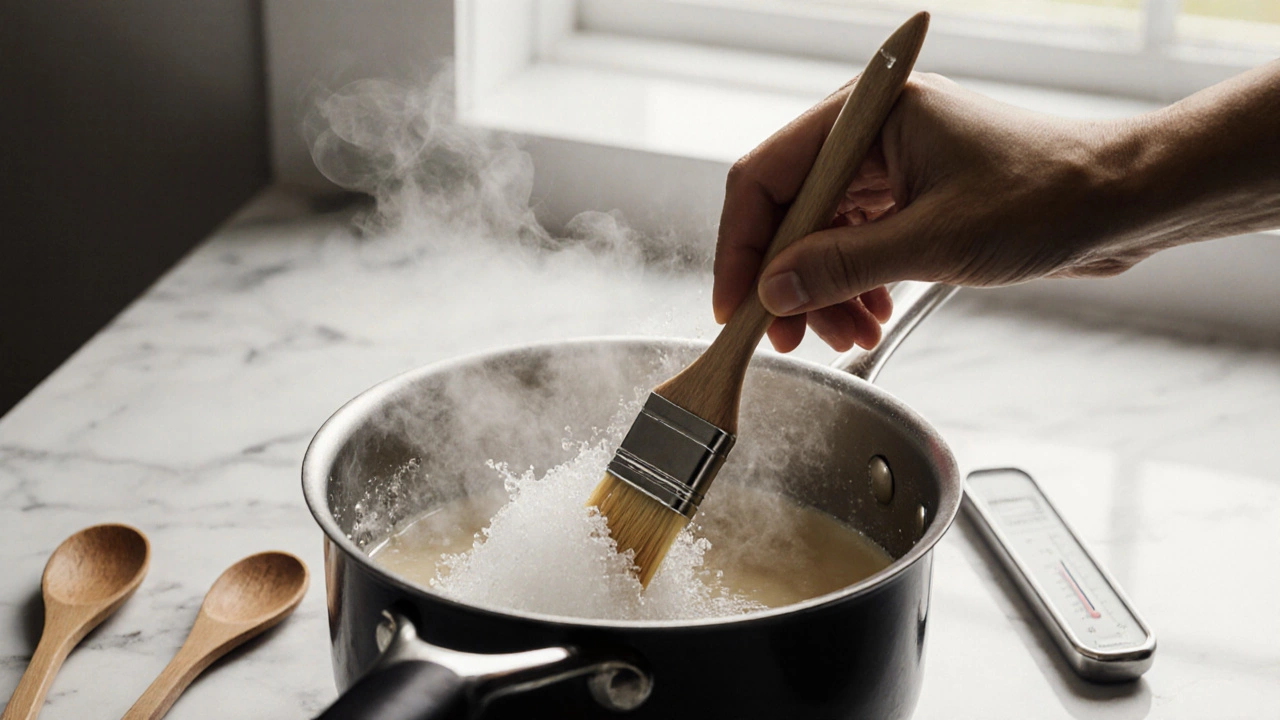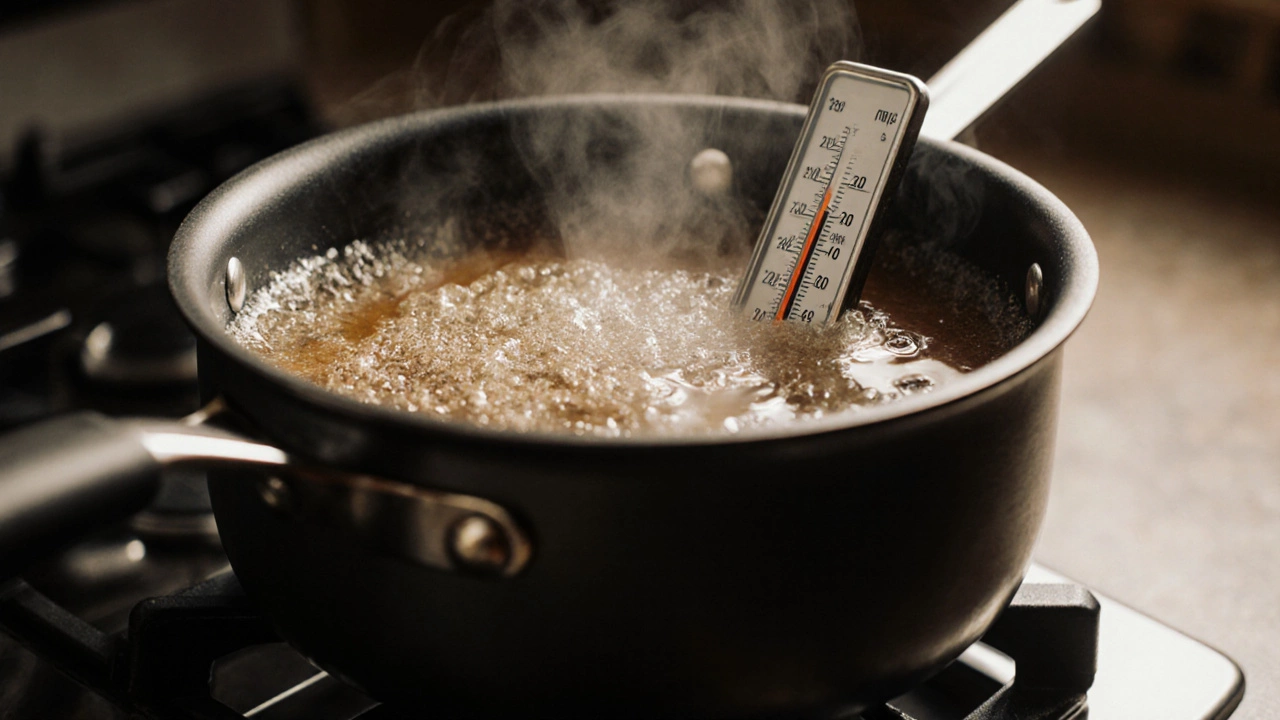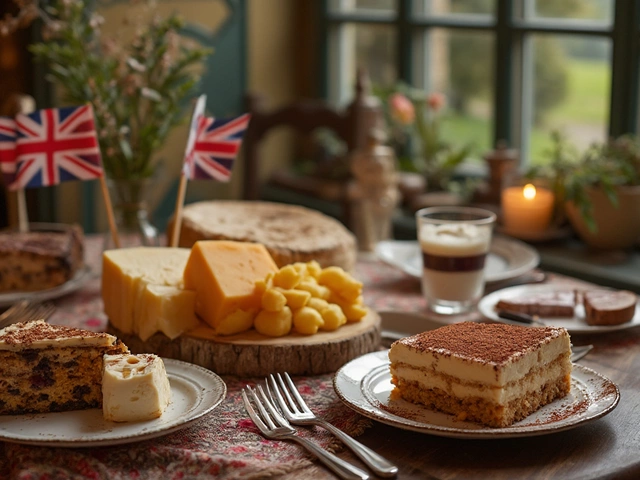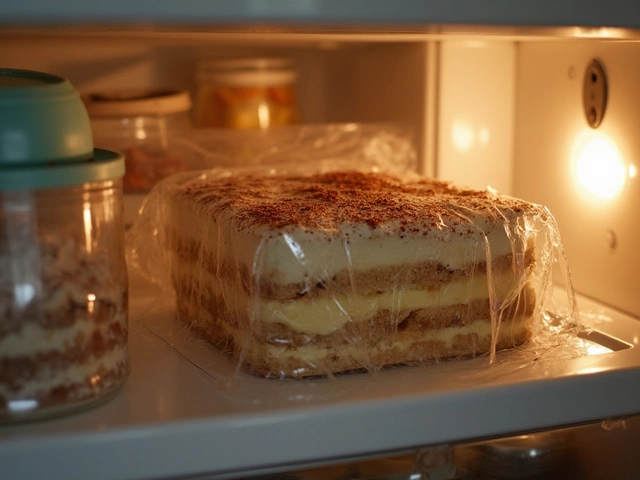Fudge Temperature Guide
Temperature Check
Check if your fudge is at the right stage for stirring or removing from heat
Ever made fudge that turned out grainy, hard, or worse - totally failed? You’re not alone. Most people blame the sugar, the heat, or the thermometer. But the real culprit? Stirring at the wrong time.
Why Stirring During Boiling Ruins Fudge
When you’re boiling the sugar mixture for fudge - usually sugar, butter, milk, and sometimes condensed milk - you’re creating a supersaturated sugar solution. That means you’ve dissolved way more sugar than water can normally hold. At this point, the mixture is like a tightly packed crowd waiting for the right moment to settle. If you stir while it’s boiling, you’re introducing tiny sugar crystals into the mix. These act like seeds. Suddenly, instead of forming one smooth, creamy texture, the sugar starts crystallizing everywhere. The result? Grainy, sandy fudge that feels like crushed rock in your mouth. This isn’t just folklore. Food scientists at the University of Guelph tested this exact scenario. They boiled identical fudge batches, stirring one constantly and leaving the other untouched. The stirred batch had 47% more visible sugar crystals under magnification. The texture was noticeably coarse. The untouched batch? Silky and smooth.When to Stir - and When to Stop
You do need to stir - just not when you think you do. Stir only during the initial mixing phase, before you turn on the heat. This ensures the sugar fully dissolves in the liquid. If you see granules clinging to the pan’s sides when you start heating, wipe them down with a wet pastry brush. That’s your last chance to stir. Once the mixture reaches a boil, stop stirring completely. Let it bubble away undisturbed until it hits the soft-ball stage (234-240°F or 112-116°C). Use a candy thermometer. Guessing won’t cut it. Fudge is unforgiving. Only after you remove it from the heat do you start stirring again - and this is where the magic happens. Let the mixture cool to about 110°F (43°C). That’s when you beat it with a wooden spoon or electric mixer until it thickens and loses its shine. That’s when the crystals form - but now, you’re controlling them. You want millions of tiny crystals, evenly spread. That’s what gives fudge its melt-in-your-mouth feel.What Happens If You Stir Too Early?
You might think stirring helps the sugar dissolve faster or prevents burning. It doesn’t. It just makes the fudge fail. Here’s what actually happens when you stir during boiling:- Crystals form on the spoon and drop back into the mixture
- Those crystals trigger chain reactions - more crystals grow around them
- The whole batch becomes uneven, with patches of hard sugar
- No amount of beating later will fix it

Pro Tips for Perfect Fudge Every Time
Here’s what works, based on decades of tested recipes and real kitchen failures:- Use a heavy-bottomed saucepan - it heats evenly and prevents hot spots that cause premature crystallization.
- Don’t scrape the sides - even a wooden spoon dragging along the edge can dislodge sugar crystals.
- Use a candy thermometer - not a guess. 234°F is the sweet spot. Go past 240°F and you’ll get chewy, not creamy.
- Let it cool before beating - if you beat it while it’s still hot, you’ll overwork it and get a rubbery texture.
- Beat until it just starts to thicken - about 5 minutes by hand, 3 minutes with a mixer. Stop when it loses its gloss and holds its shape slightly.
Common Myths About Fudge
There’s a lot of bad advice out there. Let’s clear it up:- Myth: “You need to stir to prevent sticking.” Truth: A well-greased pan and low heat prevent sticking. Stirring doesn’t.
- Myth: “More stirring = creamier fudge.” Truth: Creaminess comes from controlled crystallization after cooling - not agitation during boiling.
- Myth: “If it’s not boiling hard, it’s not ready.” Truth: Temperature matters, not bubble intensity. A gentle simmer at 234°F is perfect.

What to Do If You Already Stirred
You made a mistake. You stirred. Now what? Don’t panic. There’s a rescue method - but it’s not guaranteed. Remove the pot from heat. Let it cool to 120°F (49°C). Add 1-2 tablespoons of corn syrup. Stir gently. Corn syrup contains glucose, which interferes with sugar crystallization. Then, let it cool further to 110°F and beat as normal. It might help. It might not. But it’s better than tossing it out. I’ve saved two batches this way - both turned out decent, though not perfect.Final Answer: Don’t Stir While Boiling
No, you should not stir fudge while it’s boiling. Ever. The science is clear. The results are repeatable. The texture speaks for itself. Stirring during boiling is the single most common reason homemade fudge fails. Do your prep work. Measure carefully. Use a thermometer. Wait until it cools. Then beat it like you mean it. Fudge isn’t hard. It just needs patience. And a little discipline.Can I stir fudge after it’s off the heat?
Yes - and you should. Once the fudge mixture has cooled to about 110°F (43°C), you need to beat it vigorously. This is when you encourage the formation of tiny, uniform sugar crystals that give fudge its smooth texture. Stirring at this stage is essential - it’s what turns a hot syrup into creamy fudge.
Why does my fudge turn out grainy?
Grainy fudge happens when sugar crystals form too early or too large. The most common cause is stirring the mixture while it’s boiling. Even one stir can introduce crystals that multiply. Other causes include not dissolving sugar fully before heating, or using a dirty pan with sugar residue.
Do I need a candy thermometer to make fudge?
Yes, unless you’re an expert with decades of experience. Fudge requires precise temperature control. The soft-ball stage (234-240°F) is the only reliable indicator that the sugar syrup has the right water content. Guessing by color or bubbles leads to inconsistent results - too soft, too hard, or grainy.
Can I use a microwave to make fudge without stirring?
Microwave fudge recipes exist, but they’re not the same as stovetop fudge. Most microwave versions use condensed milk or marshmallow fluff, which don’t require boiling or precise temperature control. If you’re following a traditional recipe with sugar, milk, and butter, you still need to heat it to the soft-ball stage - even in the microwave. Stirring during heating still causes crystallization. So even then, don’t stir until it cools.
What if I don’t have a candy thermometer?
You can use the cold water test: drop a small spoonful of the boiling mixture into a glass of ice water. After 10 seconds, try to form it into a ball with your fingers. If it holds shape but still squishes easily, it’s at the soft-ball stage. If it’s too soft or runs through your fingers, keep cooking. This method is less precise than a thermometer, but it works in a pinch.





